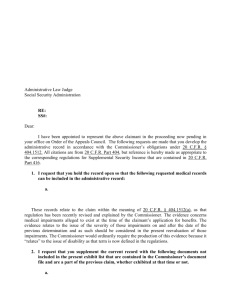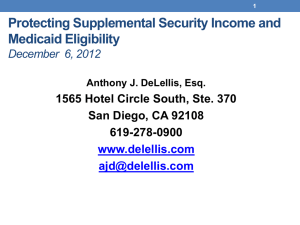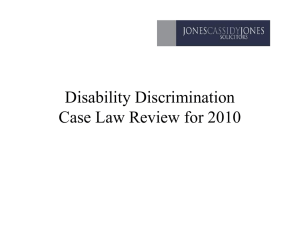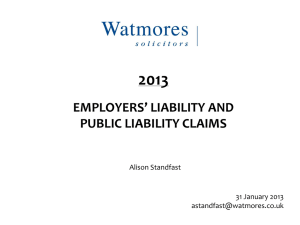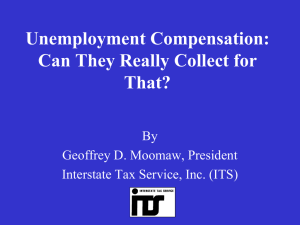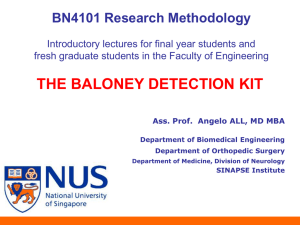Social Security Power Point Presentation
advertisement
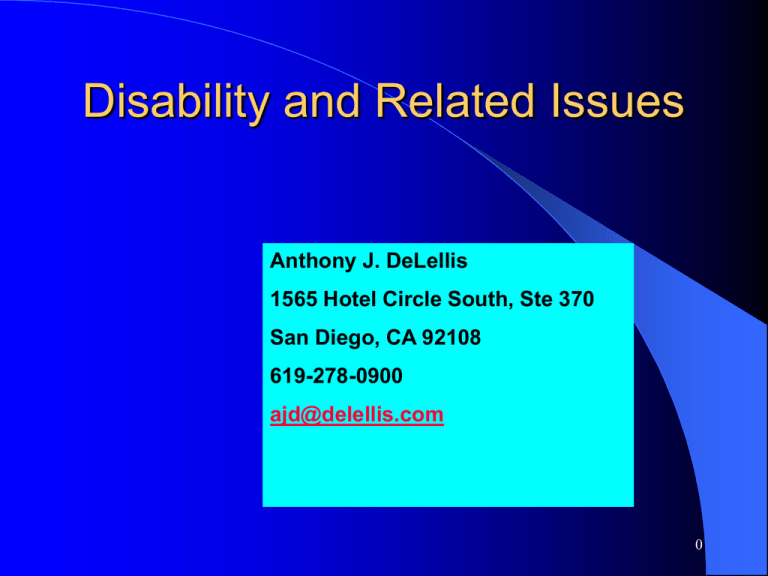
Disability and Related Issues Anthony J. DeLellis 1565 Hotel Circle South, Ste 370 San Diego, CA 92108 619-278-0900 ajd@delellis.com 0 SOCIAL SECURITY DISABILITY Disability: The inability to engage in any substantial gainful activity by reason of any medically determinable physical or mental impairment which can be expected to result in death or which has lasted or can be expected to last for a continuous period of not less than 12 months. 42 U.S.C. 423(d)(1)(A) 1 Physical or Mental Impairment: An impairment that results from anatomical, physiological or psychological abnormalities which are demonstrable by medically acceptable clinical and laboratory diagnostic techniques. 2 The Social Security Act sets a “Hypothetical Tone” for disability determinations. The SSA will not consider the availability of work in the area where the claimant lives, job vacancies or whether the individual claimant would be hired. 3 Five Step Sequential Evaluation 1. The Claimant is not engaging in “substantial gainful activity” (SGA); and 2. The Claimant has a “Severe” impairment; and 3. The impairment meets or “equals” one of the impairments in the regulations known as the “Listing of Impairments”; or 4. Considering the Claimant’s “residual functional capacity” (RFC), the Claimant is unable to do “past relevant work”; and 5. Other work with the claimant’s RFC, considering age, education and work experience, does not exist in the national economy in significant numbers. 4 1. Substantial Gainful Activity Work must be both “substantial” and “gainful”. Gainful work for 2006 was $870 per month and $900 per month for 2007. Self Employed work is “gainful” if it is the kind of work usually done for profit, regardless if there is a profit or loss. Substantial work means that the claimant is able to do the ordinary tasks of the job without special assistance or the claimant is of “little or no use” to the employer. This is referred to as a “sheltered work environment”. 5 2. Severe Impairment This step is designed to weed out frivolous claims involving no medically determinable impairment or only a “slight” impairment that results in a “minor” limitation on the ability to work. Medically determinable impairments are divided into two categories: 1) slight impairments that are referred to as “nonsevere” impairments and 2) all other impairments that are, therefore, “severe.” 6 1. The regulations require that the impairment must be continuously “severe.” This precludes conditions that wax and wane or have periods of remission followed by active periods. However if the remission is for short periods followed by active periods which preclude SGA then the duration requirement is met. 2. A claimant is not permitted to tack together unrelated severe impairments to get to the 12 month requirement. 42 U.S.C. 423(d)(2)(a). 7 3. Listings of Impairments A Claimant will be found disabled if the medical signs, findings and symptoms meet or “medically equal” one of the disabilities found in the Listing of Impairments. If meet or equals a listing, the Claimant will be found disabled even if he/she is able to do past work or hypothetically retains ability to do substantial gainful activity. 8 1. Musculoskeletal System. 2. Special Senses and Speech 3. Respiratory System 5. Cardiovascular System 4. Cardiovascular 5. Digestive System 6. Genitourinary Impairments 7. Hematological Disorders 8. Skin Disorders 9. Endocrine System 10. Impairments That Affect Multiple Body Systems 11. Neurological 12. Mental Disorders 13. Malignant Neoplastic Diseases 14. Immune System 9 4. Past Relevant Work 1. The Claimant has the burden of proving that he/she cannot perform any of the work he/she performed in the past 15 years. 2. If can perform PRW, not disabled. The case may be a winner at Step 5 but cant get there if lose at Step 4. 3. The Past Work must have been Substantial Gainful Activity. 4. Must have been performed long enough to learn that work. Each job is defined in the Dictionary of Occupational Titles and is given a specific SVP number from 1 to 8. Unskilled jobs have an SVP of 1-2 and takes 30 days to learn. Semi Skilled jobs have an SVP of 3-4 and takes 30 to 90 days to learn. Skilled jobs have an SVP of 5-9 and require 6 months up to 10 years to learn. 10 5. In evaluating a claim, I look through the claimant’s work history and determine which is the easiest job that they performed. The burden is to show what medically determinable impairments preclude him or her from performing this work now. 11 5. Other Work Does Not Exist If cant do PRW, the issue at Step 5 is whether there are jobs that exist in significant numbers that the Claimant has the Residual Functional Capacity to perform. There are Guidelines known as GRIDS which are used at this step. The GRIDS take into consideration the claimant’s “exertional limitations”. These are categorized as Sedentary, Light, Medium or Heavy. They are then combined with the claimant’s age, education and past work experience to see if there are jobs that exist in “significant” numbers that the Claimant can perform. Plugging this information into the Grids will direct a finding of disabled or not disabled. 12 Often there are “Non Exertional” Limitations. If so, the grids do not work and a vocational expert is needed who can testify how the impairments either preclude employment or erode the occupational base of jobs which exist. Non Exertional limitations include 1. Postural (e.g. alternate sit/stand, elevate legs, balance problems, difficulty bending, stooping, squatting) 2. Manipulative (e.g. reaching, grasping, handling, fingering) 3. Environmental (e.g. fumes, dust, noise, heights, humidity, moving machinery) 4. Mental (e.g. difficulty relating to others; remembering or carrying out simple instructions; inability to maintain attention or concentration; poor stress tolerance) 13 Disability Programs Social Security Disability Insurance Supplemental Security Income Widow’s Benefits 14 SSDI Requirements Medical Disability. Use the 5 step sequential evaluation. Must have worked for 20 Quarters out of the last 40 Quarters. Must earn $900 to get credit for a quarter. Earnings Requirement. Must have worked a minimum number of Quarters throughout their lifetime. This is usually a number less than 40 Quarters. 15 SSI Medical Requirements. Use the 5 step sequential evaluation. Financial Requirements. Cannot have more than $2,000 in assets. $3,000 if married. Excludes a vehicle used to transport to and from medical visits and principal residence. Must be a citizen. If non citizen, must be here legally since prior to August of 1996 unless here as a political refugee. Income limits apply. 16 Widow’s Benefits Medical Requirements. Use the 5 step sequential evaluation. Must be unmarried Must be between the ages of 50 and 60 Disability must begin before 7 years after the wage earner’s death. If divorced from the decedent, must have been married for 10 years. 17 Retroactive Benefits SSDI: The successful claimant is entitled to receive benefits back to the onset date of the disability up to a maximum of one year before the Application is filed. SSI: The successful claimant is only entitled to receive retroactive benefits from the date of the Application. 18 Attorney Fees Set by Statute. 42U.S.C. 406(a)(2)(A) 25% of Retroactive Award up to a maximum of $6000. Social Security will automatically deduct the 25% and pay the attorney directly. Costs associated with the claim are separate and a matter of agreement with the client. 19 The Hearing and Appeal Process Initial Application: 800-772-1213 Request for Reconsideration: 60 days from first denial. Hearing with an Administrative Law Judge: Must be requested within 60 days of Reconsideration denial. Appeals Council review: Must be requested within 60 days of ALJ denial. U.S. District Court: Must be requested within 60 days of Appeals Council Denial. 20 21
